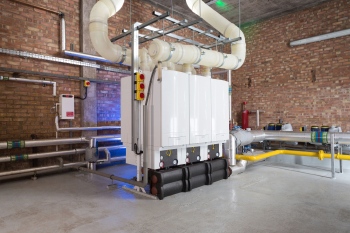New opportunities for condensing boilers

Condensing boilers have been mandatory in the domestic market for over a decade, but it is only recently that the introduction of the Energy related Products (ErP) Directive has seen the commercial sector follow suit. Pete Mills of Bosch Commercial & Industrial Heating explains what the new requirements will mean for commercial boiler installations.
In the commercial heating and hot water sector, non-condensing boiler technology has historically represented a sizable portion of the market. While the widely publicised ErP labelling initiative doesn’t apply to boilers over 70 kW in output, the directive does impact on the type of commercial boilers that need to be installed — both in new-build and replacement scenarios.
Under the requirements of the ErP Directive, a new commercial boiler with an output between 70 and 400 kW now has to be a condensing type. When you consider that the market for boilers of this size currently stands at around 3000 units sold per year, the industry has a lot of work to do to make sure the transition from the more traditional cast-iron boilers to condensing models is smooth.
Early estimates suggest that around 70% of the 3000 commercial boilers sold each year will be of the wall-hung variety, whereby systems comprising of multiple smaller-output boilers in a cascade arrangement will become more common. This will of course bring with it significant efficiency gains — not only because these boilers operate more efficiently by their nature, but also because a cascade has the ability to modulate to a small percentage of its total output. This consequently results in year-round efficiency according to seasonal demand — with each boiler effectively sharing the material amounts of wear and tear to prolong lifespan.
One area where the market will be challenged is in respect of oil-fired boilers, as the overwhelming majority of those sold at present are of a cast-iron type. Because so few oil boilers that meet the efficiency requirements of the ErP are available, we’re anticipating a significant shift towards LPG as a more accessible and cleaner alternative. This is because typically for oil to condense, and thus meet the ErP Directive’s requirements, it must be of a low-sulphur type.
Although low sulphur oil is available in a limited capacity, it doesn’t quite have the same-sized supply chain, making it much more expensive than LPG. We saw a similar shift occur in the agricultural industry back in 2011, where legislation concerning the specification of diesel changed; while ultra-low sulphur oil would have been the natural successor, the increase in demand failed to bring the price down to an affordable level.
Another challenge that will need to be overcome by the heating and hot-water industry, is how older systems will need to be dealt with. Older commercial heating and hot-water systems tend to be centred around a cast-iron atmospheric boiler. The new requirement that new boilers must be able to condense is relatively straightforward for the industry to grasp, but things start to become more complex when it comes to replacement installations.
When a cast-iron boiler breaks down and needs to be replaced, the removal of the option for the boiler to be replaced like-for-like means specifiers, contractors, and consultants will have to consider how the existing system will need to be adapted to accommodate the incoming condensing boiler.

In short, one of the main objectives is to protect the new boiler from the potentially harmful deposits that may be circulating in an older system. While emptying, treating, and re-filling the system will take place as a matter of course, old pipework is susceptible to regular build-up of particulates — which has the potential to hinder or harm boiler performance.
Where it is not practical to replace the existing pipework, a plate heat exchanger should also be installed to keep the primary boiler water separate from the secondary heating circuit and avoid cross contamination.
One of the other by-products of a condensing boiler which would not have been encountered with a cast-iron model is condensate, which needs to be managed and disposed of safely. Of equal importance, however, is the need for the condensate to be routed correctly to protect it from freezing. If the condensate discharge pipe freezes, the result is generally the boiler shutting down, so some thought needs to be given at the installation stage as to how this can be avoided.
These requirements will be by no means alien to the vast majority of installers, but the need to follow condensing-boiler best practice will grow in importance as the shift away from cast iron gathers pace.
Ultimately, as a regulation set by the European Union, the ErP Directive is designed to drive improvements in the efficiency and performance of heating and hot-water products. With the Carbon Trust having estimated that a 35% reduction in CO2 emissions could be achieved by 2020 through cost-effective efficiency measures in non-domestic buildings, the ErP Directive could yet prove key to hitting this target.
Pete Mills is commercial technical operations manager at Bosch Commercial & Industrial Heating








